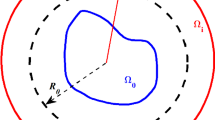Abstract
This article studies the pattern formation of reaction–diffusion Brusselator model along with Neumann boundary conditions arising in chemical processes. To accomplish this work, a new modified trigonometric cubic B-spline functions based differential quadrature algorithm is developed which is more general than (Mittal and Jiwari in Appl Math Comput 217(12):5404–5415, 2011; Jiwari and Yuan in J Math Chem 52:1535–1551, 2014). The reaction–diffusion model arises in enzymatic reactions, in the formation of ozone by atomic oxygen via a triple collision, and in laser and plasma physics in multiple couplings between modes. The algorithm converts the model into a system of ordinary differential equations and the obtained system is solved by Runge–Kutta method. To check the precision and performance of the proposed algorithm four numerical problems are contemplated and computed results are compared with the existing methods. The computed results pamper the theory of Brusselator model that for small values of diffusion coefficient, the steady state solution converges to equilibrium point \(( {\mu , \lambda /\mu })\) if \(1-\lambda +\mu ^{2}>0\).












Similar content being viewed by others
References
A.M. Turing, The chemical basis of morphogenesis. Philos. Trans. R. Soc. Lond.-Ser. B: Biol. Sci. 237, 37–72 (1952)
R. Lefever, G. Nicolis, Chemical instabilities and sustained oscillations. J. Theor. Biol. 30, 267 (1971)
G. Nicolis, I. Prigogine, Self-Organization in Non-equilibrium Systems (Wiley, New York, 1977)
I. Prigogine, R. Lefever, Symmetries breaking instabilities in dissipative systems II. J. Phys. Chem. 48, 1695–1700 (1968)
J. Tyson, Some further studies of nonlinear oscillations in chemical systems. J. Chem. Phys. 58, 3919 (1973)
P.A. Zegeling, H.P. Kok, Adaptive moving mesh computations for reaction–diffusion systems. J. Comput. Appl. Math. 168, 519–528 (2004)
E.H. Twizell, A.B. Gumel, Q. Cao, A second-order scheme for the Brusselator’ reaction–diffusion system. J. Math. Chem. 26, 297–316 (1999)
G. Adomian, The diffusion-Brusselator equation. Comput. Math. Appl. 29, 1–3 (1995)
A.M. Wazwaz, The decomposition method applied to systems of partial differential equations and to the reaction–diffusion Brusselator model. Appl. Math. Comput. 110, 251–264 (2000)
W.T. Ang, The two-dimensional reaction–diffusion Brusselator system: a dual-reciprocity boundary element solution. Eng. Anal. Bound Elem. 27, 897–903 (2003)
Siraj-ul-Islam, A. Ali, S. Haq, A computational modeling of the behavior of the two-dimensional reaction-diffusion Brusselator system. Appl. Math. Model. 34, 3896–3909 (2010)
J.G. Verwer, W.H. Hundsdorfer, B.P. Sommeijer, Convergence properties of the Runge–Kutta–Chebyshev Method. Numer. Math. 57, 157–178 (1990)
S. Kumar, Y. Khan, A. Yildirim, A mathematical modeling arising in the chemical systems and its approximate numerical solution. Asia-Pac. J. Chem. Eng. 7, 835–840 (2012)
M. Dehghan, M. Abbaszadeh, Variational multiscale element free Galerkin (VMEFG) and local discontinuous Galerkin (LDG) methods for solving two-dimensional Brusselator reaction-diffusion system with and without cross-diffusion. Comput. Methods Appl. Mech. Engrg 300, 770–797 (2016)
R.C. Mittal, R. Jiwari, Numerical study of two-dimensional reaction–diffusion Brusselator system. Appl. Math. Comput. 217(12), 5404–5415 (2011)
R. Jiwari, J. Yuan, A computational modeling of two dimensional reaction–diffusion Brusselator system arising in chemical processes. J. Math. Chem. 52, 1535–1551 (2014)
C. Shu, Differential Quadrature and its Application in Engineering (Athenaeum Press Ltd., Cambridge, 2000)
A. Korkmaz, İ. Dağ, Shock wave simulations using sinc differential quadrature method. Eng. Comput. 28(6), 654–674 (2011)
A. Korkmaz, İ. Dağ, A differential quadrature algorithm for nonlinear Schrödinger equation. Nonlinear Dynam. 56(1–2), 69–83 (2009)
R.C. Mittal, R. Jiwari, Differential quadrature method for two dimensional Burgers’ equations. Int. J. Comput. Methods Eng. Sci. Mech. 10, 450–459 (2009)
R. Jiwari, S. Pandit, R.C. Mittal, Numerical simulation of two-dimensional sine-Gordon solitons by differential quadrature method. Comput. Phys. Commun. 183(3), 600–616 (2012)
R. Jiwari, S. Pandit, R.C. Mittal, A differential quadrature algorithm to solve the two dimensional linear hyperbolic equation with Dirichlet and Neumann boundary conditions. Appl. Math. Comput. 218(13), 7279–7294 (2012)
R.C. Mittal, R. Jiwari, A differential quadrature method for numerical solutions of Burgers’-type equations. Int. J. Numer. Methods Heat Fluid Flow 22(7), 880–895 (2012)
M. Dehghan, A. Nikpour, Numerical solution of the system of second-order boundary value problems using the local radial basis functions based differential quadrature collocation method. Appl. Math. Model. 37(18–19), 8578–8599 (2013)
M.A. De Rosaa, M. Lippiello, R. Jiwari, S. Tomasiello, A Differential Quadrature based procedure for parameter identification. Appl. Math. Comput. 290, 460–466 (2016)
A. Alshomrani, S. Pandit, A.K. Alzahrani, M.S. Alghamdi, R. Jiwari, A numerical algorithm based on modified cubic trigonometric B-spline functions for computational modelling of hyperbolic type wave equations. Eng. Comput. 34(4), 1257–1276 (2017)
R. Jiwari, Lagrange interpolation and modified cubic B-spline differential quadrature methods for solving hyperbolic partial differential equations with Dirichlet and Neumann boundary conditions. Comput. Phys. Commun. 193, 55–65 (2015)
R.C. Mittal, R. Rohila, Numerical simulation of reaction-diffusion systems by modified cubic B-spline differential quadrature method. Chaos Solitons Fract. 92, 9–19 (2016)
R. Jiwari, S. Singh, A. Kumar, Numerical simulation to capture the pattern formation of coupled reaction-diffusion models. Chaos Solitons Fract. 103, 422–439 (2017)
M. Sun, Y. Tan, L. Chen, Dynamical behaviors of the brusselator system with impulsive input. J. Math. Chem. 44(3), 637–649 (2008)
A.B. Gumel, W.F. Langford, E.H. Twizell, J. Wu, Numerical solutions for a coupled non-linear oscillator. J. Math. Chem. 28(4), 325–340 (2000)
S. Kumar, Y. Khan, A. Yaldirim, A mathematical modeling arising in the chemical systems and its approximate numerical solution. Asia-Pac. J. Chem. Eng. 7(6), 835–840 (2012)
Author information
Authors and Affiliations
Corresponding author
Rights and permissions
About this article
Cite this article
Alqahtani, A.M. Numerical simulation to study the pattern formation of reaction–diffusion Brusselator model arising in triple collision and enzymatic. J Math Chem 56, 1543–1566 (2018). https://doi.org/10.1007/s10910-018-0859-8
Received:
Accepted:
Published:
Issue Date:
DOI: https://doi.org/10.1007/s10910-018-0859-8




